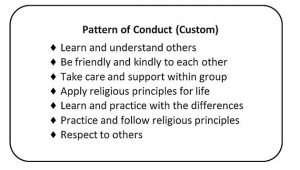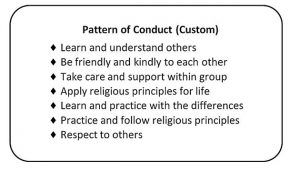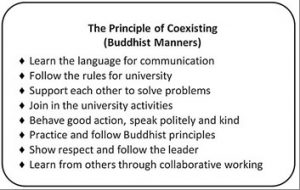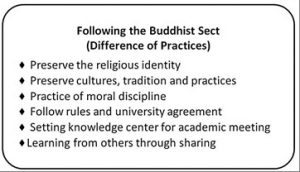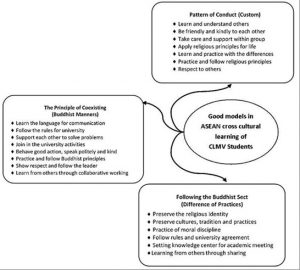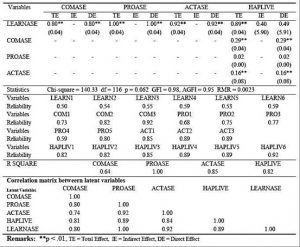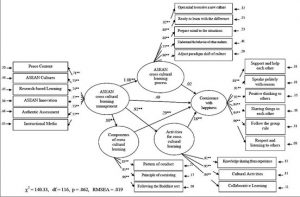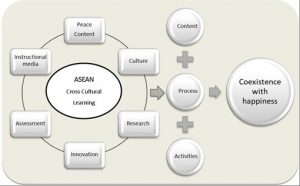Development of an Instructional Model of ASEAN Cross Cultural Learning of CLMV Students in Mahachulalongkornrajavidyalaya University
Assoc.Prof.Dr.Phra Rajvaramethi,
Vice-Rector for Administration, MCU and others
* Asst.Prof.Phrakhruwimonsinlapakit,
Phrabaidika Suphot Ketnakorn, Asst.Prof.Dr. Phichet Thangto, Asst.Prof.Dr.Rittichai Kamnak, Asst.Prof.Dr.Phrapalad Raphin Buddhisaro, Asst.Prof.Dr. Jatuphum Ketchatturat, Dr.Lampong Klomkul
and Mr.Kavipon Srihamongkol
The purpose of this research article were 1) to study ASEAN cross cultural learning of CLMV students studying at Mahachulalongkornrajavidyalaya University from good practice case studies, and 2) to develop and assess the quality of the instructional model of ASEAN cross cultural learning of CLMV students in Mahachulalongkornrajavidyalaya University. Multiphase mixed methods research applying quantitative research to extend qualitative results was used for research design. The qualitative target group was selected using purposive sampling whereas the quantitative sampling group was used two-stage random sampling. Guideline for interview and focus group discussion and questionnaires were used for measurement design. Qualitative data were classified and analyzed using content analysis and analytic induction. Quantitative data were analyzed by descriptive statistics and the developed model was validated by using LISREL program. Results showed that good models of ASEAN cross cultural learning of CLMV students studying at Mahachulalongkornrajavidyalaya University composed of 3 aspects including: 1) pattern of conduct, 2) the principle of coexisting, and 3) following the Buddhist sect. The instructional model of ASEAN cross cultural learning relating to consequent factors leading to a happy coexistence included 5 components as the following: 1) ASEAN cross cultural learning management; 2) components of ASEAN cross cultural learning; 3) ASEAN cross cultural learning process; 4) activities for cross cultural learning; and 5) coexistence with happiness following the principle of virtues for fraternal living (Saraniyadham). The developed model had its possibility, validity, appropriateness and benefit for the related students and instructors. The structural equation model of the instructional model of ASEAN cross cultural learning fit with the empirical data (Chi-square=140.33, df=116, p=0.062, GFI=0.98, AGFI=0.95, RMR=0.023). It clearly showed that ASEAN cross cultural learning management, components of ASEAN cross cultural learning, ASEAN cross cultural learning process and activities for cross cultural learning were capable of promoting a happy coexistence.
Introduction
Education in Thailand has originally started from the temple. For higher education, there are two Buddhist universities that still play important role of increasing level of people education both academic and morality. Mahachulalongkornrajavidyalaya University is one of higher education institutes, and it is a Buddhist university that opens for Thai people and foreigners who interested in studying both academic and moral practice. The university has been established as a government university since 1997. The university has developed both hardware and software aspects in order to prepare learners to be ready for the development of being a center of Buddhism in national and international levels continually. The main purpose of educational management is also related to ASEAN Community (ASEAN refers to the Association of Southeast Asian Nations) that is the education for encouraging each other by training and conducting research including Southeast Asia Studies. Students from educational institutes are encouraged to realize and understand each other by sharing knowledge between ASEAN countries that related to the third pillar of ASEAN cultures and societies. The target of this cooperation is to build the unity within community by sharing and supporting each other as in [1], [2]. For this reason, lectures and instructors should be able to organize classroom activities to increase student’s learning in various ways and covers with five aspects consisted of 1) cognitive domain, 2) affective domain,
- psychomotor domain, 4) skills and 5) These are learning models for international learning as in [3].
In the university community, it is an educational institute of students who come from different countries and have the differences in races, languages and traditions living together in the campus. When people from two or more cultures interact with each other on the regular basis, it results in multiculturalism. They need to adjust their styles as well as their communication patterns to fit the styles of the host nation as in [4]. Considering in the university community, activities have been organized by
students to enhance living together peacefully which is the main purpose of educational management that the faculty members wish to see them to encourage each other to cooperate and join in activities together creatively and also complement each other. According to their ethnicity or country, they are not divided into groups. On the other hand, when the understanding occurs, the coordination in the activities of the university can be easily carried out both in the classroom and outside the classroom in accordance with the goals of the university that focuses on training students to have both knowledge and morality. Then, they can apply into the society after graduation.
Students in Mahachulalongkornrajavidyalaya University are diverse and different in races, languages, religions and traditions especially students who come from CLMV countries consisted of Cambodia, Laos, Myanmar and Vietnam. They need to live together on campus, but from this distinction resulting in the management of education or living and activities being separate both inside and outside the classroom. Therefore, the university needs to find ways or learning methods to manage learning in order to encourage cross cultural learning for students who are the host to have a better understanding of the culture of students from ASEAN countries in order to have effectively learning and adapting to understand other cultures in ASEAN.
Research Objectives
-
To study ASEAN cross cultural learning of CLMV students studying at Maha- chulalongkornrajavidyalaya University from good practice case studies.
-
To develop and assess the quality of the instructional model of ASEAN cross cultural learning of CLMV students in Mahachulalongkornrajavidyalaya University.
Scope of Research
This research article is designed by using a multiphase mixed methods research design. The population of this research is students from Mahachulalongkornrajavidyalaya University and the target group are lectures and educators from CLMV countries. The content used in this study consists of 1) cultural concepts, 2) ASEAN culture in CLMV countries, 3) religious culture, 4) cross cultural learning, 5) learning management using research based learning, and 6) model of cross cultural learning management. Scopes of variables of qualitative study are pattern of conduct (custom), the principleof coexisting (Buddhist manners), and following the Buddhist sect (difference of practices). Variables for quantitative study are 5 latent variables consisted of ASEAN cross cultural learning management (LEARNASE), components of ASEAN cross cultural learning (COMASE), ASEAN cross cultural learning process (PROASE), and activities for cross cultural learning (ACTASE) and coexistence with happiness (HAPLIVE) and twenty-three observed variables that use for the analysis.
Methods
Multiphase mixed methods research applying quantitative research to extend qualitative results was used for research design. The qualitative target group was selected using purposive sampling whereas the quantitative sampling group was used two-stage random sampling. Guideline for interview and focus group discussion and questionnaires were used for data collection. Qualitative data were classified and analyzed using content analysis and analytic induction. Quantitative data were analyzed by descriptive statistics and developed model was validated by using LISREL program. Four phases were designed in this research. The first phase used field study with in-depth interview for studying case studies that are being best practices of cross cultural learning in CLMV countries. Phase 2 used focus group discussion to develop and examine ASEAN cross cultural learning management in CLMV countries. Phase 3 used the model of ASEAN cross cultural learning management in CLMV countries for conducting workshop with Mahachulalongkornrajavidyalaya University students. In phase 4 was a quantitative research design to assess the quality of the developed model. Evaluation of the quality of ASEAN cross cultural learning management model of Mahachulalongkornrajavidyalaya University students by examining the validity of the causal relationship model developed. Population and sample group were undergraduate students who registered in Mahachulalongkornrajavidyalaya University in academic year 2018. Determine the size of the sample group by using the formulas of Hair and others (1998) as in [5]. The sample size is 10 people per 1 parameter. Two-stage random sampling method can be used. Questionnaires were used for data collection and quantitative data were analyzed using descriptive statistics. In the hypothesis test, the research used validation of the structural equation model with the LISREL program.
Results
Figure 1: A Step of Research Design
Good models of ASEAN cross cultural learning of CLMV students studying at Mahachulalongkornrajavidyalaya University composed of 3 aspects which are pattern of conduct, the principle of coexisting and following the Buddhist sect. Results of this research can be shown as below:
- Pattern of Conduct (Custom)
Pattern of conduct is the way of daily life practicing for Buddhist monks or layman according to the Buddhist phrase called “Practicing is the representative of leader’s teaching” as in [6]. The meaning of this principle of practice can be the key or mechanism to preserve the status of religious followers such as venerable, novices and Buddhists who come from Lao PDR, Cambodia, Myanmar, Vietnam and Thai. There are two parts of custom which are principles and practices. For the principle, students will live and follow pattern of conduct based on their backgrounds such as Lao PDR, Cambodia, Myanmar and Thai follow the principle of Theravada Buddhism whereas Vietnam follows Mahayana Buddhism. For practices, students practice is based on their teachers or religious masters who have taught them both from their countries and Buddhist University. Summary for pattern of conduct is shown as in Figure 2.
Figure 2: Pattern of Conduct for CLMV Students
-
The Principle of Coexisting (Buddhist Manners)
Principle of living together is a form of practice that related to beliefs and traditional which has a pattern from tradition or a practice that has been done. It has continued from Buddhism traditional dress pattern, color of cloth, practice about eating, eating at different times. For example, Mahayana from Vietnam will eat a food without meat. In addition, there are some different practices from different countries such as the use of different colored fabrics of monks in each country or each sect, some shaving the eyebrows whereas some are not shaving the eyebrows. These showed the similarities and differences in the case of tradition especially tradition due to religion. Even one implication is joint learning and one implication is conflict, they are still defining the attitude towards expression in those practices. Results from interviewing instructors and CLMV country students about the principles of coexistence can be shown in Figure 3.
Figure 3: The Principle of coexisting for CLMV students
-
Following the Buddhist Sect (Difference of Practices)
Respect for Buddhism is a practice related to religious sects and is different through forms such as instruction Related to the dress between Mahayana of Vietnam and Theravada in Thai, Myanmar, Laos, Cambodia. The Theravada denominations will affect dressing, robes, mantras, prayers. These practices are due to the religious sects associated with the expression and living together from the traditions and practices that occurred. In relation to sect’s ethnicity as in the case of Theravada in Vietnam, the majority of people are Cambodians. Mahayana is only a group of Vietnamese people. Ethnic differences in Myanmar with respect to Theravada Buddhism, such as the large Thai Mon ethnic groups, Burma Karen, or those who are Buddhists who are native living in Rakhine State, which has a significant effect on the practice denomination as shown in Figure 4.
Figure 4: Following the Buddhist Sect of CLMV Students
Good models of ASEAN cross cultural learning of CLMV Students in Mahachulalongkornrajavidyalaya University composed of 3 aspects including:
- pattern of conduct (custom) such as learning oneself and others with empathy,
mutually maintaining kindness (Kanlayanamitta) and practicing the religious principles;
- the principle of coexisting (Buddhist manners) such as learning languages for communication, following the rules and regulations of the university, practicing Buddha Dhamma or the teaching of Buddha and mutually respecting each other; and 3) following the Buddhist sect such as conserving custom, tradition and ways of practice, following the Dhamma discipline (Dhammavinaya) and having learning center for exchanging Summary of Good models in ASEAN cross cultural learning of CLMV students can be shown as in Figure 5.
Figure 5: Good models in ASEAN cross cultural learning of CLMV Students
In analyzing the data of this model, there are 5 latent variables: ASEAN cross cultural learning management (LEARNASE), components of ASEAN cross cultural learning (COMASE), ASEAN cross cultural learning process (PROASE), activities for cross cultural learning (ACTASE) and coexistence with happiness (HAPLIVE) and 23 observed variables were used for the analysis.
Results of quantitative quality assessment is to create a pattern that can be used for generalizability model by examining the consistency between the structural equation model of ASEAN cross cultural learning management in CLMV countries which developed from the qualitative research including the experimental model and empirical data obtained from the real condition of cross cultural learning as perceived by Mahachulalongkornrajavidyalaya University students. The results showed that the developed model from the relationship between the composition and variables of the model of ASEAN cross cultural learning management in CLMV countries fit with empirical data (Chi-square=140.33, df =116, p = 0.062 GFI = 0.98, AGFI = 0.95, RMR=0.023). When considering the predictive coefficient (R-square) of the latent internal variable structure equation, it found that the components of the cross cultural learning (COMASE) had the forecast coefficient equal to 0.64, indicating that the variables within the model of ASEAN cross cultural learning management (LEARNASE) can explain the variance of components of ASEAN cross cultural learning for 64.00 percent. ASEAN cross cultural learning process (PROASE) has a predictive coefficient equal to 1.00, i ndicating that the variables within the model of ASEAN cross cultural learning management (LEARNASE), able to explain the variance of ASEAN cross cultural learning process for 100 percent. Activities for cross cultural learning (ACTASE) has a predictive coefficient of 0.85, indicating that the variables within the model of cross cultural learning management (LEARNASE) can explain the variance of activities for cross cultural learning at 85.00 percent. Coexistence with happiness (HAPLIVE) has a predictive coefficient of 0.82, indicating that the variables within the model of ASEAN cross cultural learning management (LEARNASE), components of ASEAN cross cultural learning (COMASE), ASEAN cross cultural learning process (PROASE), and activities for cross cultural learning (ACTASE) can explain the variance of coexistence with happiness at 82.00 percent.
When considering the correlation matrix between latent variables, it indicated that the correlation coefficient range between latent variables was in the range of 0.74 to 1.00, with all pairs having the same directional correlation and positive correlation values. The variables with the highest correlation coefficients are ASEAN cross cultural learning management (LEARNASE) and the cross cultural learning process (PROASE) with correlation coefficients equal to 1.00 indicating that when increasing the management of ASEAN cross cultural learning, the level of ASEAN cross cultural learning process is also increased. The next variables with correlation coefficients followed by ASEAN cross cultural learning process (PROASE) and activities for cross cultural learning (ACTASE) with correlation coefficients equal to 0.92 indicating that when the level of ASEAN cross cultural learning process increase, the level of activities for cross-cultural learning has also increased. In addition, correlation coefficients of ASEAN cross cultural learning management (LEARNASE) and activities for cross cultural learning (ACTASE) is also equal to 0.92 indicating that when the level of ASEAN cross cultural learning management, the level of activities for cross cultural learning has also increased and showed a high level of correlation.
When considering the direct effect and indirect effect between variables in the model, it was found that the relationship between the ASEAN cross cultural learning manage- ment variables (LEARNASE) and coexistence with happiness (HAPLIVE) is equal to 0.89 (r = 0.89) is a direct influence 0.49 and indirect effect is 0.40, the total effect is 0.89. Direct and indirect effects do not affect the coexistence with happiness significantly. However, the total effect size has a significant effect on coexistence with happiness. Detail of analysis results are shown in Table 1 and Figure 6.
Table 1 Statistical analysis of correlation between latent variables and factor analysis
of developed model
Symbol of latent variables that appeared in the developed model as below:
LEARNASE refers ASEAN cross cultural learning management COMASE refers components of ASEAN cross cultural learning PROASE refers ASEAN cross cultural learning process ACTASE refers activities for cross cultural learning
HAPLIVE refers coexistence with happiness
Figure 6: A Causal model of ASEAN Cross Cultural Learning of CLMV Students in Mahachulalongkornrajavidyalaya University
Discussions
The first aspect of discussion is to focus on a studying of best practice case study that is a good example of cross cultural learning in ASEAN countries, it was found that learners and instructors who come from CLMV countries most of them are Buddhists and adopt religious practices as a way of life. In three countries, Cambodia, Lao PDR and Myanmar, Theravada Buddhism is respected whereas in Vietnam respects Mahayana Buddhism. However, when the population of these countries has the opportunity to live together in the same society and doing the same activity together, there will be differences in the ways of practice of each race, even if respecting the same religion. Therefore, the process of learning in each other’s culture is necessary and is an opportunity to reduce the cultural gap by making each person turn to learn each other including opening up to accept other cultures from friends who come from many different cultures from ASEAN countries as shown in Mahachulalongkorn- rajavidyalaya University, the Buddhist University of Thailand. There are students from ASEAN countries especially in the CLMV countries who come to study in religious and
various academic sciences. When they are coming to study in the same community, it would make an opportunity to interact with each other both activities in the classroom and outside the classroom. Therefore, resulting in learning is shown in the pattern of self-practice such as learn to know each other, pay attention other ideas, maintain good friendships, take care and help each other within a group or denomination. As the result, religion has influence on well-being, learn about the differences of self-practice, and practice according to the principles of religion. For the concept of cross cultural learning process, there are five steps, including 1) open to accept new culture, 2) prepare the mind to learn different things, 3) prepare mind to the situations,
4) understand the behavior of other students, and 5) adjust the paradigm of culture. This step is learning, understanding, adjusting and leading to understand the cultural adaptation process that is consistent with the six dimensions that shown in [7]. Researcher suggested that to be a knowledgeable and understanding person in other cultures that are differently intelligent, they must consist of a six-dimensional
cognitive paradigm consisting of the 1st dimension is to understand what the culture
intended to show (declaration), the 2nd dimension is to understand the procedural process of the culture, the 3rd dimension is to understand the consistency (analogical), the 4th dimension is to know the pattern recognition, the 5th dimension is to know how to do external scanning, and the 6th dimension is to be consciousness (self-awareness). One who can adjust themselves to fulfill these six dimensions, he or she can be a culture conscious person at all times. This is starting from learning, understanding and putting in a participatory manner through adaptation in order to learn and be able to live in different cultures. In addition, there is a common to the majority of Buddhist cultures of Northern ASEAN nations including Thailand, Lao PDR, Myanmar and Cambodia, all have a similarly elegant from physical greeting made by placing both hands together palm with finger pointing upwards. The greeter holds hands higher and bows deeper as the age, seniority, or status of the greeted rises. Researcher has proposed the guidelines to avoid cross cultural problems, these are some guiding practices consisted of 1) try to understand other cultures, 2) respect each other,
3) keep an open mind and think positively, 4) adapt and improve yourself and avoid having a negative mindset, and 5) understand the beliefs, values, and rules of cultures as mentioned in [8].
The second aspect of discussion related to workshop activities in accordance with the model of ASEAN cross cultural learning management in CLMV countries, it was found that participants were interested in continuing to participate in activities starting with Think-Pair-Share, brainstorming, knowledge sharing, and group activities in order to develop learning innovations through a storyline and planning for innovation with mind mapping technique. Results from students’ reflections after participating in the activity indicated that they knew how to obtain information and understand trough additional activities with research based leaning, systematic presentation through the planning process, creative thinking, and communicate to the public with fully understand others. These are learning activities that apply research based learning of conducting ASEAN cross cultural learning for CLMV students in Mahachulalongkorn- rajavidyalaya University in accordance with the research as in [9], research on teaching and learning management that students use as part of the learning process by integrating teaching by using research-based method along with content analysis. The research found that students are interested in pursuing knowledge and have skills in acquiring self-knowledge whereas the research that showed in [10] that studies on the continuous professional development of measurement and evaluation using research as a tertiary base in Thailand. The researcher suggested that research based learning is important for Thai university research. Indicators reflected the success of student learning assessment by using the learning process with 3 stages of research:
1) creating self-thinking, 2) focusing on change, and 3) reflecting change and presenting development guidelines. The development results through this process led to the development of the participants using research based learning. In addition, the teaching and learning management that is used as a base is still widely seen in the management of Thai education that has shown in [11] to synthesize the research results that are used by learning and using research is the base of Thai education. It found that research is aimed at developing learners in basic education level. The variables found from synthesis are work skills, thinking skills, academic achievement nature of researchers, basic research and problem solving skills, critical thinking including seeking knowledge and attitudes. It can be seen that learning management is a teaching technique that helps to develop a variety of skills. Therefore, this research is to develop cross cultural learning management and choose to use for learning management as a base to develop ASEAN cross cultural learning of CLMV students.
The third aspect of discussion related to the model of learning management across ASEAN from theory into practice, the process of developing a model for this research started with a qualitative study to develop a conceptual framework for research in a manner that shows the relationship between variables in order to obtain guidelines for developing field area variables from in-depth interviews, surveys and observations. According to variables and issues of interest to study, the findings obtained from in-depth interviews led to the addition of variables in the research framework to be clearer and important, consistent with the social and cultural context. Model and practices of people from different cultural backgrounds under the similarities of Buddhism, the variables are clear and begin to develop the learning activity manage- ment process. Develop a learning set about the religious culture of CLMV countries creates a learning management plan. To be used as a guideline for organizing workshop activities and then conduct an examination of the appropriateness and feasibility of conduct from education experts and ASEAN education. When the pattern is clear in every component and there is a process that is ready, there is a workshop activity that is designed into practice. Based on the results of the development of learners with practical activities, the ASEAN cultural innovation design program has 24 tasks which participants will be able to create media or innovations about ASEAN culture to disseminate knowledge about religious culture. In ASEAN, however, in the development of innovation that are some video clips have been developed from students. There is the development of 24 group tasks showing in mind map style, but they have not completed video clips as the innovation. It appears the reflection and thinking of the students who attended the workshop because of having the opportunity to learn together, do group activities, practice searching information from online media, present work via online media, to express opinions through the process of ASEAN cross cultural learning which is an essential skill for learners in the 21st century as in [12] that study “The relationship between skills in the 21st century with digital technology skills”, by presenting the results of the study that are the necessary skills in the 21st century obtained from the synthesis of 25 articles in total of 7 main areas consisting of academic skills, information management, communication, collaborative learning, creative thinking, critical thinking and problem solving. Related context skills have been included for this study such as ethical awareness, cultural awareness, flexibility, self-directed learning, and lifelong learning. From the mentioned reasons, it shows that model of ASEAN cross cultural learning management can be developed from theory
into practice and can be useful for teaching and learning management that is consistent with the development of learner skills in the 21st century. The variables found from synthesis are work skills, thinking skills, academic achievement nature of researchers, basic research and problem solving skills, critical thinking including seeking knowledge and attitudes. It can be seen that learning management is a teaching technique that helps to develop a variety of skills. Therefore, this research is to develop cross cultural learning management and choose to use for learning management as a base to develop ASEAN cross cultural learning for CLMV students.
Lesson Learned from the Research
From studying ASEAN cross cultural learning management from target groups with good practices enabling information to be used in group discussions and develop the ASEAN cross cultural learning management model in CLMV countries for the Mahachulalongkornrajavidyalaya University students. The workshop of organizing active activities in the country with Mahachulalongkornrajavidyalaya University students 4 sites and also 1 organizing activity in ASEAN country. Then, lesson learned from reflection were used for the analysis and develop quantitative research tools in order to assess the quality developed causal relationship model. The result of the data analysis resulted in the findings that answered the research objectives and get the ASEAN cross cultural learning management model in the CLMV countries for the complete Mahachulalongkornrajavidyalaya University students. From the causal relationship model of ASEAN cross cultural learning management in the CLMV countries for Mahachulalongkornrajavidyalaya University students, it is consistent with the actual situation of cross-cultural learning of Mahachulalongkornrajavidyalaya University students where ASEAN cross cultural learning management will result in a happy coexistence that requires components of ASEAN cross cultural learning content, including patterns of self-practice, principles of living together and respect for Buddhism. It is an important part in the design of the learning process management for students to learn across ASEAN culture in accordance with the 5-step process:
1) open to accept new culture, 2) prepare the mind to learn different things, 3) prepare mind to the situations, 4) understand the behavior of others, and 5) adjust the paradigm of culture. There are form of activities that promote cross cultural learning such as exchanging learning from their own experiences, cultural activity demonstration, and cooperative learning combined with the summary of ASEAN cross cultural learning
management, components of ASEAN cross cultural learning, ASEAN cross cultural learning process and activities for cross cultural learning can promote a happy living together as well.
From the phrase of “differences is not the conflict” in the meaning of CLMV context, it is the co-cultures that are the same phenomena of Buddhism, learning, adaptation, and culture of living. Therefore, it is very important to initiate the understanding and adaptation in order to live together. Buddhist University in Thailand is the educational institute that provides the opportunity for students from different cultures and other aspects to learn and to live together. Students have adjusted themselves under the different conditions. The target of living is to have creative life within the community under learning environment in order to approach to cross cultural learning in multicultural context. The development of ASEAN cross cultural learning model consisted of six aspects of ASEAN cross cultural learning which are the content of peace, cultural integration, research-based learning, creating innovation, authentic assessment, and applying instructional media. Lesson plan will be included with content, process and learning activities in order to enhance the level of coexistence with happiness for students who live in the university community. ASEAN cross cultural learning model can be shown in Figure 7.
Figure 7: ASEAN Cross Cultural Learning Model
Conclusion
Good models of ASEAN cross cultural learning of CLMV students studying at Mahachulalongkornrajavidyalaya University focuses on three aspects consisted of
1) pattern of conduct, 2) the principle of coexisting, and 3) following the Buddhist sect. The result of quality assessment, learning management model both qualitative and quantitative concluded that managing ASEAN cross cultural learning will result in a happy living place that requires the components of ASEAN cross cultural learning content such as patterns of self-practice, principles of living together, and respect for Buddhism which is used as an important part in the design of the learning process management for students to learn across ASEAN culture in accordance with the 5-step process:1) open mind to receive a new culture, 2) ready to learn with the difference,
3) prepare mind to the situations, 4) understand the behavior of other students, and
5) adjust paradigm shift of culture. The model of activity is to promote cross cultural learning consisted of exchanging learning from their own experiences and cultural activity demonstration through collaborative learning. In summary, ASEAN cross cultural learning management, components of ASEAN cross cultural learning, ASEAN cross cultural learning process and activities for cross cultural learning can promote a happy living together in the society.
Acknowledgement
This research article has completed with high cooperative working of research team who spent their times of conducting research on field studies in ASEAN countries. They have shown great encouragement to support all research process with effectively. I would like to thank Asst.Prof. Phrakhruwimonsinlapakit, Phrabaidika Suphot Ketnakorn, Asst.Prof.Dr. Phichet Thangto, Asst.Prof.Dr.Rittichai Kamnak, Asst.Prof.Dr.Phrapalad Raphin Buddhisaro, Asst.Prof.Dr.Jatuphum Ketchatturat, Dr.Lampong Klomkul and Mr.Kavipon Srihamongkol with appreciation for all of the hard work. I would like to express thanks to National Research Council of Thailand, the organization that provided us financial support for the research project. The most important person for special thanks is the former rector of Mahachula longkorn- rajavidyalaya University (Most Ven. Prof. Dr. Phra Brahmapundit) who has signed for the contract of research fund and has given us the permission of studying with bachelor degree students and facility for conducting research.
References
- Piboonsongkram, “Building the connection in ASEAN for Thai usefulness,” ASEAN
Highlight, pp. 50-53, 2011.
The Office of Strategy and Evaluation, “Knowledge of ASEAN community,” Bangkok:
National Office of Buddhism Publisher, 2013.
- Khamanee, “Learning management by the learner used research as the learning process,” Bangkok: Office of Research and Educational Development, 2007.
- Apiwanworarat, “Cross Culture and Diversity in ASEAN” in The ASEAN Community and Beyond, Bangkok: Chulalongkorn University Printing House, p.285, February 2018.
J.F. Hair, R.E. Anderson, R.L.Tatham, and W.C. Black, “Multivariate data analysis,” 5th
edition, Englewood Cliffs, New Jersey: Prentice Hall, 1998.
Mahachulalongkornrajavidyalaya, Thai Tipitaka of MCU version, Bangkok: Mahachu-
la-longkornrajavidyalaya Press, 1996. Press, (T. Maha (Thai) 461/612/01).
- Earley, and S. Ang, Cultural intelligence: individual interactions across cultures. Stanford University Press Stanford: USA, 2003.
- Apiwanworarat, “Cross Culture and Diversity in ASEAN” in The ASEAN Community and Beyond, Bangkok: Chulalongkorn University Printing House, p.294, February 2018.
- Intraprawat, ”Teaching integration through research, content analysis, and writing process in English writing essay teaching in discussion,” in Teaching and instruction by the learner used research as the learning process, Bangkok: Khrurusapaladprao Publisher, pp. 2632005 ,290-.
- Junpeng, and A. Tungkasamit, “The continuing professional development of the assessment through research-based learning in Higher Education of Thailand,” Social and Behavioral Sciences, 143(2014), pp. 737 – 742.
- Srikoon, and others, “Research Synthesis of Research-Based Learning for Education
in Thailand,” Social and Behavioral Sciences, 116 (2014), pp. 913 – 917.
E.V. Laar, and others, “The relation between 21st century skills and digital skills: A systematic literature review,” Computers in Human Behavior, Vol.72, pp. 577-588, July 2017.

ผลงานทางวิชาการนี้ พิมพ์เผยแผ่ในสารนิพนธ์พุทธศาสตรบัณฑิต-Buddhist Graduates Thematic Paper ในนาม พระราชวรเมธี,รศ.ดร. และคณะ (ดร.ลำพอง กลมกูล ฯ) เรื่อง “Development of an Instructional Model of ASEAN Cross Culture Learning of CLMV Students in Mahachulalongkornrajavidyalaya University” จัดพิมพ์เนื่องในพิธีประสาทปริญญาบัตรประจำปี 2562/2019 (25-26 พฤษภาคม 2562) มหาวิทยาลัยมหาจุฬาลงกรณราชวิทยาลัย หน้า 455-474
(Click เพื่ออ่าน https://bit.ly/2WmEVoE)


